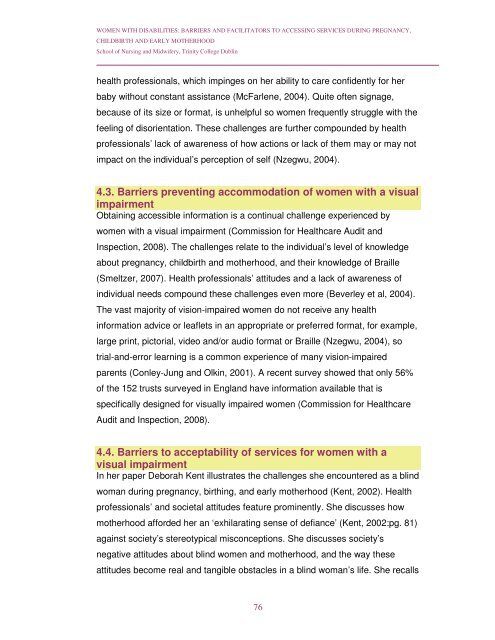Women with Disabilities: Barriers and Facilitators to Accessing ...
Women with Disabilities: Barriers and Facilitators to Accessing ...
Women with Disabilities: Barriers and Facilitators to Accessing ...
Create successful ePaper yourself
Turn your PDF publications into a flip-book with our unique Google optimized e-Paper software.
WOMEN WITH DISABILITIES: BARRIERS AND FACILITATORS TO ACCESSING SERVICES DURING PREGNANCY,CHILDBIRTH AND EARLY MOTHERHOODSchool of Nursing <strong>and</strong> Midwifery, Trinity College Dublinhealth professionals, which impinges on her ability <strong>to</strong> care confidently for herbaby <strong>with</strong>out constant assistance (McFarlene, 2004). Quite often signage,because of its size or format, is unhelpful so women frequently struggle <strong>with</strong> thefeeling of disorientation. These challenges are further compounded by healthprofessionals’ lack of awareness of how actions or lack of them may or may notimpact on the individual’s perception of self (Nzegwu, 2004).4.3. <strong>Barriers</strong> preventing accommodation of women <strong>with</strong> a visualimpairmentObtaining accessible information is a continual challenge experienced bywomen <strong>with</strong> a visual impairment (Commission for Healthcare Audit <strong>and</strong>Inspection, 2008). The challenges relate <strong>to</strong> the individual’s level of knowledgeabout pregnancy, childbirth <strong>and</strong> motherhood, <strong>and</strong> their knowledge of Braille(Smeltzer, 2007). Health professionals’ attitudes <strong>and</strong> a lack of awareness ofindividual needs compound these challenges even more (Beverley et al, 2004).The vast majority of vision-impaired women do not receive any healthinformation advice or leaflets in an appropriate or preferred format, for example,large print, pic<strong>to</strong>rial, video <strong>and</strong>/or audio format or Braille (Nzegwu, 2004), sotrial-<strong>and</strong>-error learning is a common experience of many vision-impairedparents (Conley-Jung <strong>and</strong> Olkin, 2001). A recent survey showed that only 56%of the 152 trusts surveyed in Engl<strong>and</strong> have information available that isspecifically designed for visually impaired women (Commission for HealthcareAudit <strong>and</strong> Inspection, 2008).4.4. <strong>Barriers</strong> <strong>to</strong> acceptability of services for women <strong>with</strong> avisual impairmentIn her paper Deborah Kent illustrates the challenges she encountered as a blindwoman during pregnancy, birthing, <strong>and</strong> early motherhood (Kent, 2002). Healthprofessionals’ <strong>and</strong> societal attitudes feature prominently. She discusses howmotherhood afforded her an ‘exhilarating sense of defiance’ (Kent, 2002:pg. 81)against society’s stereotypical misconceptions. She discusses society’snegative attitudes about blind women <strong>and</strong> motherhood, <strong>and</strong> the way theseattitudes become real <strong>and</strong> tangible obstacles in a blind woman’s life. She recalls76
















